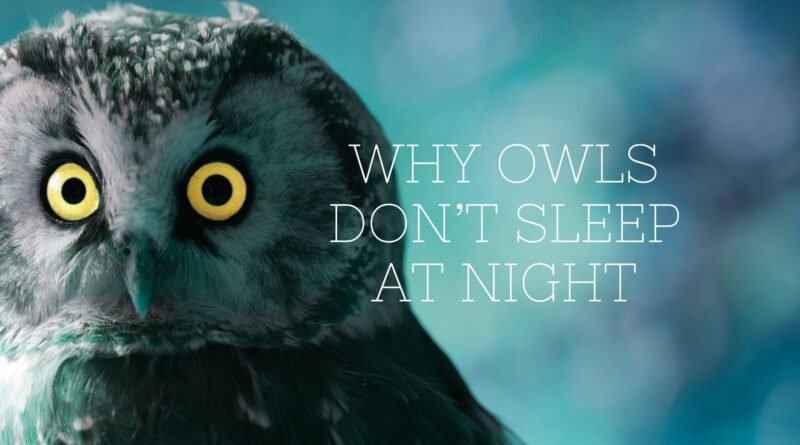Science behind why owls don’t sleep at night – It’s all about their hunting strategies
Almost all of us are curious about why owls don’t sleep at night. We all have heard stories about this night-time adventurer. But hardly any of us know the real science behind this particular behavior of owls.
Though this is true that most owls don’t sleep at night but that’s not a complete truth. Many of the species of owls do sleep at night and hunt in the day-time. For instance, the Snowy owl (Bubo scandiacus) and Burrowing owl (Athene cunicularia) sleep at night and remain active throughout the day.
So, what exactly determines owls’ day-night cycle?
According to different research, the main reasons behind owls’ different day-night cycles are their hunting strategies, history as nocturnal raptors, and prey availability.

Adaptation to nocturnal and diurnal lifestyles in owls:
The owls are raptors (birds of prey) that hunt and feed on vertebrates for their survival. The adaptation to nocturnal (active at night) and diurnal (active in day-time) lifestyles in owls depends on the availability of their preferred prey.
A research article proposes two hypotheses to justify the nocturnal (active at night) and diurnal (active in day-time) lifestyles of owls or all birds in general. The article was published in the journal, “Evolution Volume 71, Issue 8” in the year 2017. The journal mainly publishes manuscripts and other writing materials related to evolutionary biology to encourage and enhance the understanding of evolutionary biology.
The researchers, Samantha R. Anderson and John J. Wiens, from the Department of Ecology & Evolutionary Biology, University of Arizona mentioned two hypotheses in their research paper.
- The first and widely supported hypothesis is that the common ancestors of birds had diurnal lifestyles. An ocean of morphological and genetic evidence is available to entail that all the common birds’ ancestors were active during the day. Therefore, the descendant birds with slight evolutionary changes are active throughout the day.
- The second hypothesis suggests that owls’ common ancestors had nocturnal lifestyles with a little touch of cathemeral (active 24 hours). This hypothesis proposes that common ancestors had a similar lifestyle to mammals (active during both day and night time).
At the present, there is no substantial proof to solidify either of the hypotheses. The expert biologists believe that owls’ nocturnality (active at night) and diurnality (active at day) depends on the availability of the prey and their independent evolution with a common diurnal ancestor.

Why most owls don’t sleep at night?:
The best possible answer to this question is the anatomy or body structure of owls. As mentioned in the book, Handbook of the Birds of the World, owls have perfectly cryptic plumage coloration and exceptional hearing and vision for hunting at night. The owls have silent feathers that make them highly tuned for hunting at night or even in the day. The feathers of the owl with a serrated leading edge and fringe trailing edge aid the owl’s hearing in finding prey. The softer feathers not only allow the owl to concentrate on the prey but also improve the hunting success rate.
Another reason for owls’ night-time hunting habits is their power to see in the dim light. Katherine V. Fite in her research article, Anatomical and behavioral correlates of visual acuity in the great horned owl, mentions that the owl’s retina has a well-defined convexiclivate fovea (high-acuity vision). The fovea has both rod and cone cells (vision cells in the eye). Cone cells in the retina help us to see in bright light whereas rod cells aid us to see in dim light. The owl retina has more rod cells than humans. These rod cells are what enable the owls to see and hunt at night. Also blessed with binocular vision and large tubular eyes, owls are highly skilled in finding their prey at night.
Being the only nocturnal raptor (bird to hunt at night), the owl enjoys hunting and feeding without worrying about other predators. With unique traits like a facial desk and asymmetrical ears, owls can easily find prey in darkness by hearing. The majestic-looking bird only walks at night to hunt and feed. Owls’ nocturnal behaviors allow them to have a smooth hunting experience.
In another research article that was published in the year 2020, the team of researchers studied the nocturnal predatory lifestyle of the owl by a genome-wide scan approach. The research article was published in the journal, “Genome Biology and Evolution, Volume 12, Issue 10”, in October 2020. The research team collected genomes from 20 bird species:
- 11 Strigiformes (Owls)
- 2 Accipitriformes (Hawks, Eagles, Vultures, Kites, etc.)
- 4 Coraciimorphae (Mousebirds, Cuckoo roller, Trogons, etc.)
- 1 Falconiform (Falcons or Caracaras)
- 1 Passeriform (Songbirds, Old World sparrow, Finches, etc.)
- 1 Galliform (Turkey, Grouse, Chicken, etc.)
All the birds in the study were diurnal (active at daytime) except for the eleven nocturnal owls. The research team found that owls have evolved sensory adaptations. These adaptations are what allow owls to cope with a dark or dim light in their night-time adventures. The owls have phototransduction in the rods that aid hunting at night. The research team also found nocturnal evolutionary evidence of the owls with their ancestors. The study supported the notion that owls have independent nocturnal raptors history.
Expert biologists summarize the nocturnal and diurnal behavior of the owls as the personal prey choice and biological evolution. Some owls have evolved over the years to become diurnal raptors. Other owls don’t sleep at night as it’s their ideal hunting time.




